
Ancistrus is a genus of nocturnal freshwater fish in the family Loricariidae of order Siluriformes, native to freshwater habitats in South America and Panama. Fish of this genus are common in the aquarium trade where they are known as bushynose or bristlenose catfish. In the aquarium hobby they are often referred to as bushynose or bristlenose plecos instead, but this may lead to confusion as "pleco" usually is used for Hypostomus plecostomus and its allies and is often used as a catchall term for any loricariids remotely resembling that species.

Loricariidae is the largest family of catfish, with 92 genera and just over 680 species. Loricariids originate from freshwater habitats of Costa Rica, Panama, and tropical and subtropical South America. These fish are noted for the bony plates covering their bodies and their suckermouths. Several genera are sold as "plecos", notably the suckermouth catfish, Hypostomus plecostomus, and are popular as aquarium fish.

Hypostomus is a genus of catfish in the family Loricariidae. They are native to tropical and subtropical South America. H. plecostomus is the popular freshwater aquarium fish formerly known as Plecostomus plecostomus. The taxonomic structure of the Loricariidae is still being expanded by scientists. Hypostomus is a highly species-rich and widely distributed catfish genus.

Peckoltia is a genus of small South American armored suckermouth catfishes. Many of these fish are popular aquarium fish.

Hemiancistrus is a genus of suckermouth armored catfishes. These species are native to South America. The taxonomy of this genus is complex and unclear, and major work has to be done. Many of these fish are popular aquarium fish.
Rhadinoloricaria is a genus of catfish endemic to South America. It was considered to be monotypic until the 2020 discovery of a second species.
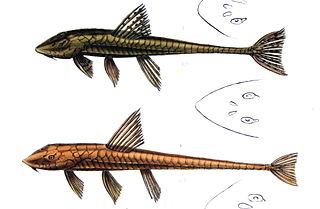
Loricariichthys is a genus of catfishes of the family Loricariidae.
Harttia is a genus of armored catfishes native to South America.

Ancistrini is a tribe of catfishes of the family Loricariidae. Most are restricted to tropical and subtropical South America, but there are also several genus in southern Central America.
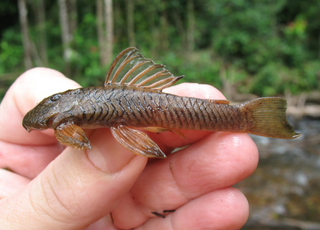
Guyanancistrus is a genus of suckermouth armored catfishes.

Panaqolus is a genus of small catfish in the family Loricariidae native to rivers in tropical South America. Its members were formerly thought to belong to a clade of small-sized species in the genus Panaque, until this genus was separated from Panaque in 2001. At times it has been considered a subgenus of Panaque, and the validity of the genus has been disputed by various authors and sources. Pseudoqolus koko was formerly considered to be a member of this genus, although it was reclassified as a member of the currently monotypic genus Pseudoqolus by Nathan K. Lujan, Christian A. Cramer, Raphael Covain, Sonia Fisch-Muller, and Hernán López-Fernández following a 2017 molecular phylogenetic analysis.

Peckoltia sabaji is a species of catfish in the family Loricariidae. It is native to South America, where it occurs in the basins of the Rupununi, the Essequibo River, and the Takutu River in Guyana, as well as the basins of the Casiquiare canal, the Rio Negro, the Cinaruco River, and the Orinoco in Venezuela. It is usually found among boulders in medium to large rivers. The species reaches 19.8 cm SL and is of disputed classification.
Yaluwak is a genus of armored catfish native to South America where they are only known from Guyana, containing only a single species Yaluwak primus. It was first described in a 2020 study and placed within the tribe Ancistrini.
Pseudoqolus koko is a species of catfish in the family Loricariidae and the only species in the genus Pseudoqolus. It is a freshwater fish native to South America, where it occurs in the Maroni basin. It is usually found on or near stony substrates in the main river channel at a depth of around 2 m. The species has been collected alongside multiple other loricariid species, including Hemiancistrus medians, Peckoltia otali, Pseudancistrus barbatus, Harttia guianensis, Loricaria cataphracta, and Rineloricaria stewarti. It is noted that the gut contents of one specimen of this species contained primarily spicules and sponge fragments, indicating that it may feed on freshwater sponges. The species reaches 9 cm SL.
Peckoltia capitulata is a species of catfish in the family Loricariidae. It is native to South America, where it occurs in the Approuague River in French Guiana. It was initially collected from an area of the river with a swift, strong current that was noted to be unusually turbid at the time of collection due to illegal gold mining in the area. The species reaches 7.6 cm SL. Its specific epithet, capitulata, is derived from Latin and reportedly refers to the characteristically small head of the species.
'Pseudancistrus' megacephalus is a species of catfish in the family Loricariidae. It is of uncertain and disputed classification.
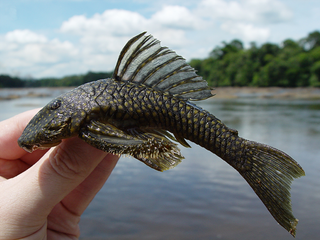
Guyanancistrus longispinis is a species of catfish in the family Loricariidae that is of disputed classification. It is native to South America, where it occurs in the Oyapock basin in French Guiana. It is typically seen in shallow rapids with rocky substrates and moderate levels of illumination. It is known to occur alongside the species Guyanancistrus brevispinis, Harttia fowleri, and Crenicichla ternetzi, as well as members of the genus Ancistrus. The species reaches 10.4 cm in standard length and may be a facultative air-breather.
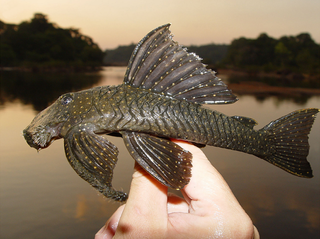
Guyanancistrus niger is a species of catfish in the family Loricariidae that is of disputed classification. It is native to South America, where it occurs in the Oyapock basin in French Guiana. Though reportedly uncommon, it is typically seen in rapids where the species Pseudancistrus barbatus is also present, although the ecological relationship between the two is not known. The species reaches 15.9 cm in standard length, although it has been reported to reach 25.4 cm, and it may be a facultative air-breather.
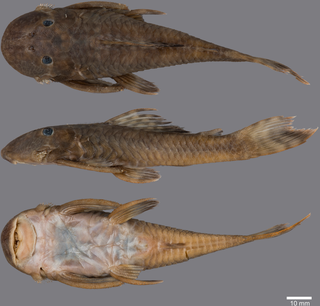
Guyanancistrus teretirostris is a species of catfish in the family Loricariidae. It is a freshwater fish native to South America, where it occurs in the upper Paru de Oeste River in Brazil. The species reaches 9.8 cm in standard length. Its specific epithet, teretirostris, is derived from Latin and refers to the rounded shape of the species' snout.

Loricariichthys platymetopon is a species of catfish in the family Loricariidae. It is native to South America, where it occurs in the Río de la Plata basin in Argentina, Brazil, and Paraguay. The species reaches maturity at around 15.7 cm in length, although it can grow up to 39 cm in total length. It can reach at least 311 g in weight and is believed to be a facultative air-breather.
















